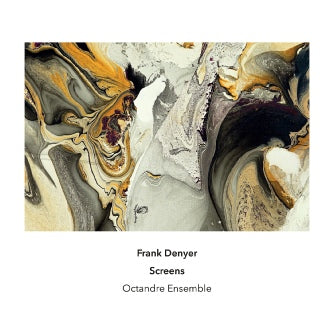at220
Frank Denyer
Screens
Frank Denyer
Featuring: Frank Denyer Octandre Ensemble
Couldn't load pickup availability
1 Broken Music (1990) 14:38
for flute, contra-bassoon, melodica, cello, harp, banjo & 2 percussionists
2 Unison 1 (1973) 5:44
version for female voice, flute, clarinet, violin & viola
3 Screens (2017/18) 14:31
for female voice, flute, violin, viola, 2 percussionists & speaker
4 Unison 3 (1973) 5:58
version for male voice, bass flute, clarinet, viola & cello
5-9 Five Views of the Path (2020/21) 20:31
for female voice, violin, three flutes, mandolin & 2 percussionists
Octandre Ensemble:
conductor: Jon Hargreaves
voice: Juliet Fraser & Joshua Ballance
flutes: Richard Craig, Audry Milheres, Ilze Ikse, Taylor MacLennan
bassoon & contra-bassoon: Patrick Bolton
violin: Benjamin Marquise Gilmore
viola: Richard Jones
cello: Corentin Chassard
banjo & mandolin: Sam Cave
percussion: Calum Huggan, Adam Cracknell & Angela Wai Nok Hui

There is a 10-page booklet about the music on the CD by Christian Mason, from which the following is an extract:
An Unfamiliar Terrain
Frank Denyer’s music is full of questions, but never pretends to easy answers. Rather, it offers us a fluid space for imaginative reflection on the nature of music and the fragile condition of human culture more generally. Sometimes these questions are - or appear to be - benign ‘compositional questions’, such as how to create a particular blend of colour within an ensemble (as in Unisons), or how to create subtle timbral changes through spatial disposition (as in Screens), but behind such particular questions, which give their creative spark to individual pieces, there lurks a bigger and more troubling question, strikingly exemplified on this disc by the seemingly incongruous array of instruments that comprise Broken Music, Screens and Five Views of the Path.
It is a question of how to meaningfully cohere the diverse, and sometimes conflicting, raw elements of our contemporary awareness into an authentic - one might almost say truthful - musical expression, in the midst of a world where the very context of our artistic and cultural experience is so heavily mediated by coercive commercial and political forces that we can never be quite sure that quiet/individual voices will even be heard, however urgent their message. This artistic quest is informed not only by Denyer’s sense of historical crisis within the tradition of Western composition, but by his extensive ethnomusicological fieldwork through which he has been in close contact with, and documented, traditional cultures which have since been largely obliterated by so-called ‘progress’. Such first-hand experience of barely-noticed cultural loss has undoubtedly strengthened Denyer’s resolve to continue the quest. As Bob Gilmore put it in 2003: “His whole concern with musical instruments, new, modified or nearly extinct, can perhaps be seen as a metaphor for the larger question of what can be salvaged, artistically, from the chaos of civilisation as we begin a new century.” The century may not be so new now, but this need to re-evaluate the essentials of music-making through the lens of atypical resources continues to define Denyer’s ever-searching artistic attitude....
The works collected here span almost fifty years of creative activity, and a wide sonic palette, yet they are connected by a thread that has remained constant at the heart of Denyer’s music since the early 1970’s, namely melody. Denyer’s insistence on the primacy of the horizontal direction of music was in stark contrast to the prevailing musical environment when it first became a compositional preoccupation, as he explains: “Following some leads that came from writing and re-writing A Book of Emblems and Songs I found with the Unison set that I had somehow strayed into, what seemed at the time, an unfamiliar musical terrain. Remember that at this stage I was just an innocent, tentatively trying to absorb this new situation and find my way about.” This attraction to the possibilities of ‘unfamiliar terrain’ conveys itself, in the Unisons, through the timeless freshness of the melodic language, which eschews any sense of pre-determined structure in favour of an intangible quality where the melody seems to discover itself as it ebbs and flows, and occasionally - for brief moments - splits in two.”
You can read the whole of the booklet here

